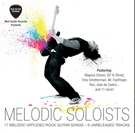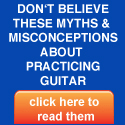How To Make A Great Guitar Solo

There are lots of ways to make guitar solos. Most guitarists focus on ‘what to play’ versus ‘how to play things’. Fact is, the nuances of phrasing (‘how’ the notes are played) often matter MORE than the notes we actually play. How many times have you heard someone play a solo ‘without’ much emotion? Often there was nothing wrong with their choice of notes. The solo lacked emotion and interest because the ‘phrasing’ was weak.
Guitar Phrasing is the most important aspect to creating great guitar solos, yet very few guitar players learn to develop this key element of their guitar playing.
One of the best things you can do to make better guitar solos is to carefully study your favorite singers. In the late 1990s, I began to study the vocal styles of my favorite singers. I learned to play on guitar every little nuance of their vocal phrasing and vibrato… and most importantly, the ‘musical contexts’ in which they made various phrasing and vibrato choices when singing. Singers cannot do many of things that we can do on the guitar, but they can naturally and effortlessly do things that are not common (but are still possible) to do on the guitar.
Listen to your favorite singers and notice the difference between their vocal phrasing (‘how’ they sing notes and phrases) and your guitar phrasing (‘how’ you play your notes and phrases). Then listen carefully to how these singers construct their phrases and compare that to how you create your guitar solos. When you really pay attention to this, you will probably make some very cool and powerful observations. This can be one of the best guitar solo lessons you can ever have. It can be a real eye (and ear) opening experience that can lead you to discover MANY new ideas that you can use to make you’re your own great guitar solos.
Here are three things you can learn and implement into your playing immediately so that you can consistently make better guitar solos.
Delayed Vibrato: Listen to how many singers sing a note (without vibrato at first) and then begin to apply vibrato to it a few moments later. The vast majority of guitar players don’t do this when soloing; instead they apply the vibrato immediately to the note. Although this can also sound good, it gets old to always immediately apply vibrato when you use it. So play a note on your guitar, let it ring out naturally (without vibrato) for a moment, then apply vibrato to it. In addition to creating a more ‘vocal style of guitar playing’ you may also notice that the note you just played sustains longer. (more on this in the video below).
Movement between notes: As you know, when playing notes on a piano there is no ability to ‘bend’ notes. Singers frequently ‘bend’ notes in both directions (up or down in pitch), although downward ‘bent’ notes are more common in most vocal styles. Guitar players frequently bend notes, but 99% of the time they only bend notes ‘up’ (in pitch).
(more on this in the video below).
Intuitive Emotional Expression: Singers often manipulate tension and dissonance intuitively. They might sing the 9th of a chord because it makes a very specific emotional feeling. Most (non jazz) guitar players would naturally play the root while making a guitar solo (especially at the end of a phrase). This happens because guitar players typically are thinking about patterns and scale positions. And thus the ear is conditioned to ‘find the consonant notes’ when beginning and ending phrases while creating (or improvising) guitar solos. Singers don’t have ‘patterns’ and ‘positions’ to think about. They are only focused on their intuition – the emotion of each note they sing. This results in more natural options for the singer (compared to many ‘inexperienced’ guitar players) particularly at the beginnings and endings of phrases.
Watch the video below to see exactly what I’m talking about and hear a live demonstration of each.
To get more help with your guitar playing check out my 10 Free Guitar Solo Tips.
About the author: Tom Hess is a professional guitarist and teaches electric guitar lessons online.
© Tom Hess Music Corporation. All Rights reserved.










